
The Battle of Solferino on 24 June 1859 resulted in the victory of the allied French army under Napoleon III and the Piedmont-Sardinian army under Victor Emmanuel II against the Austrian army under Emperor Franz Joseph I. It was the last major battle in world history where all the armies were under the personal command of their monarchs. Perhaps 300,000 soldiers fought in the important battle, the largest since the Battle of Leipzig in 1813. There were about 130,000 Austrian troops and a combined total of 140,000 French and allied Piedmontese troops. After the battle, the Austrian emperor refrained from further direct command of the army.

The Battle of Sacile on 16 April 1809 and its companion Clash at Pordenone on 15 April saw an Austrian army commanded by Archduke John of Austria defeat a Franco-Italian army led by Eugène de Beauharnais and force it to retreat. Sacile proved to be the most notable victory of John's career. The action took place east of the Livenza River near Sacile in modern-day Italy during the War of the Fifth Coalition, part of the Napoleonic Wars.

The Battle of Abensberg took place on 20 April 1809 between a Franco-German force under the command of Emperor Napoleon I of France and a reinforced Austrian corps led by Feldmarschall-Leutnant Archduke Louis of Austria. As the day wore on, Feldmarschall-Leutnant Johann von Hiller arrived with reinforcements to take command of the three corps that formed the Austrian left wing. The action ended in a complete Franco-German victory. The battlefield was southeast of Abensberg and included clashes at Offenstetten, Biburg-Siegenburg, Rohr in Niederbayern, and Rottenburg an der Laaber. On the same day, the French garrison of Regensburg capitulated.
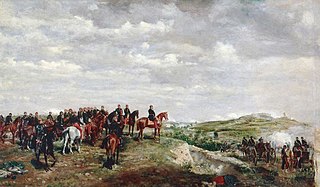
The Second Italian War of Independence, also called the Sardinian War, the Austro-Sardinian War, the Franco-Austrian War, or the Italian War of 1859, was fought by the Second French Empire and the Kingdom of Sardinia against the Austrian Empire in 1859 and played a crucial part in the process of Italian Unification.

The Battle of Varese was fought on 26 May 1859 at Varese (Lombardy). It was an engagement of the Second Italian War of Independence, fought between the Italian volunteers formation of the Hunters of the Alps, led by Giuseppe Garibaldi, against Austrian troops led by Karl von Urban. The Austrian defeat allowed the movement of the Hunters towards Como, and obliged the Austrians to keep troops on the northern part of the front.
This is the complete order of battle of the French and Third Coalition armies during the Battle of Austerlitz.

The Battle of Palestro was fought on 30–31 May 1859 between the Austrian Empire and the combined forces of the Kingdom of Sardinia-Piedmont and France. The Franco-Piedmontese forces were victorious. It was fought just south to Palestro, a town in what is now the province of Pavia in northern Italy. It was believed that the Battle of Palestro was the last European battle in which a European Monarch rode into battle, that being King Victor Emmanuel II, who directly entered the fray with the Austrians.
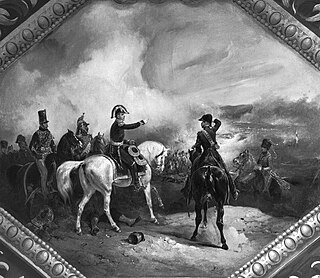
The Battle of Haslach-Jungingen, also known as the Battle of Albeck, fought on 11 October 1805 at Ulm-Jungingen north of Ulm at the Danube between French and Austrian forces, was part of the War of the Third Coalition, which was a part of the greater Napoleonic Wars. The outcome of this battle was a French victory.
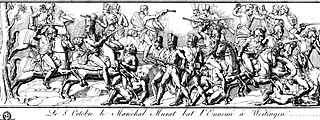
In the Battle of Wertingen Imperial French forces led by Marshals Joachim Murat and Jean Lannes attacked a small Austrian corps commanded by Feldmarschall-Leutnant Franz Xaver von Auffenberg. This action, the first battle of the Ulm Campaign, resulted in a clear French victory. Wertingen lies 28 kilometres (17 mi) northwest of Augsburg. The combat was fought during the War of the Third Coalition, part of the Napoleonic Wars.
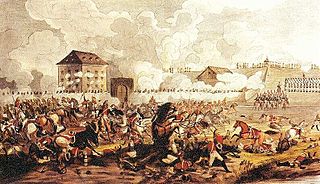
The Battle of Raab or Battle of Győr was fought on 14 June 1809 during the Napoleonic Wars, between Franco-Italian forces and Habsburg forces. The battle was fought near Győr, Kingdom of Hungary, and ended in a Franco-Italian victory. The victory prevented Archduke John of Austria from bringing any significant force to the Battle of Wagram, while Prince Eugène de Beauharnais's force was able to link up with Emperor Napoleon at Vienna in time to fight at Wagram. Napoleon referred to the battle as "a granddaughter of Marengo and Friedland", as it fell on the anniversary of those two battles.

François Xavier de Schwarz or François-Xavier-Nicolas Schwartz was born in Baden but joined the French army in 1776. He became a cavalry officer during the French Revolutionary Wars, fighting with the 2nd Hussar Regiment in numerous actions including Jemappes, Fleurus, and Neuwied. After being captured in an abortive invasion of Ireland, he was promoted to command the 5th Hussar Regiment. He led the unit in the War of the Second Coalition, most notably at Hohenlinden and in the subsequent pursuit of the Austrians.

In the Montenotte campaign between 10 and 28 April 1796, General Napoleon Bonaparte's French Army of Italy broke the link between Feldzeugmeister Johann Peter Beaulieu's Austrian army and Feldmarschallleutnant Michelangelo Alessandro Colli-Marchi's Sardinian army. In subsequent engagements, the French defeated the Austrians, pursued Colli to the west, and forced the Sardinians to withdraw from the First Coalition against France. Actions were fought at Voltri on 10 April, Monte Negino (Legino) on 11 April, Montenotte on 12 April, Millesimo on 13 April, Second Battle of Dego on 14–15 April, Ceva on 16 April, San Michele Mondovi on 19 April, and Mondovì on 21 April.

Count Ferenc Gyulay de Marosnémethi et Nádaska, also known as Ferencz Gyulai, Ferencz Gyulaj, or Franz Gyulai, was a Hungarian nobleman who served as Austrian Governor of Lombardy-Venetia and commanded the losing Austrian army at the Battle of Magenta.

The Battle of Graz took place on 24–26 June 1809 between an Austrian corps commanded by Ignaz Gyulai and a French division led by Jean-Baptiste Broussier. The French were soon reinforced by a corps under Auguste Marmont. The battle is considered a French victory though Gyulai was successful in getting supplies to the Austrian garrison of Graz before the two French forces drove him away from the city. Graz, Austria is located 145 kilometers south-southwest of Vienna at the intersection of the modern A2 and A9 highways.

The Battle of Tarvis from 16 to 17 May 1809, the Storming of the Malborghetto Blockhouse from 15 to 17 May 1809, and the Storming of the Predil Blockhouse from 15 to 18 May saw the Franco-Italian army of Eugène de Beauharnais attacking Austrian Empire forces under Albert Gyulai. Eugène crushed Gyulai's division in a pitched battle near Tarvisio, then an Austrian town known as Tarvis. At nearby Malborghetto Valbruna and Predil Pass, small garrisons of Grenz infantry heroically defended two forts before being overwhelmed by sheer numbers. The Franco-Italian capture of the key mountain passes allowed their forces to invade Austrian Kärnten during the War of the Fifth Coalition. Tarvisio is located in far northeast Italy, near the borders of both Austria and Slovenia.
Count Albert Gyulay de Marosnémethi et Nádaska or Albert Gyulai von Máros-Németh und Nádaska, born 12 September 1766 – died 27 April 1835, a Hungarian, joined the army of Habsburg Austria and fought against Ottoman Turkey. He served against the First French Republic in the Flanders Campaign and on the Rhine. Severely wounded in 1799, he survived a trepanning operation and briefly retired from military service. He returned to active service and commanded an army corps during the War of the Fifth Coalition, part of the Napoleonic Wars. He led his troops in several important battles during the Austrian invasion of Italy in 1809, including one where he was in independent command. Though appointed to command troops in 1813 and 1815, he missed combat in both campaigns. He was Proprietor (Inhaber) of an Austrian infantry regiment from 1810 until his death. The more famous Ignác Gyulay, Ban of Croatia was his older brother.
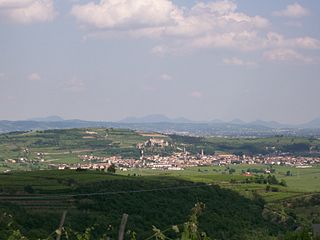
In the Battle of Caldiero or Battle of Soave or Battle of Castelcerino from 27 to 30 April 1809, an Austrian army led by Archduke John of Austria defended against a Franco-Italian army headed by Eugène de Beauharnais, the Viceroy of the Kingdom of Italy. The outnumbered Austrians successfully fended off the attacks of their enemies in actions at San Bonifacio, Soave, and Castelcerino before retreating to the east. The clash occurred during the War of the Fifth Coalition, part of the Napoleonic Wars.
The Piave River 1809 order of battle shows the units and organization for the Franco-Italian and Austrian Empire armies that fought in the Battle of Piave River on 8 May 1809. Eugène de Beauharnais, the viceroy of the Kingdom of Italy defeated Archduke John of Austria. Eugène's Advance Guard crossed the river first and was assailed by Austrian cavalry and artillery. The French cavalry routed the opposing cavalry and captured 14 enemy guns. A lull followed as John arranged his infantry in a formidable defensive position. Meanwhile, Eugène struggled to pour reinforcements into the bridgehead as the Piave rose dangerously. In the afternoon, the viceroy sent Paul Grenier to drive back the Austrian left while Jacques MacDonald mounted an assault on the center. The attack succeeded in breaking the Austrian line and compelling John to order a retreat.

The Battle of Volta Mantovana of 1848 was an engagement during the First Italian War of Independence fought throughout Volta Mantovana on 26 and 27 July 1848 between the Second Austrian army corps of General Konstantin D'Aspré and the 3d Piedmontese division of general Ettore De Sonnaz. It resulted in a decisive Austrian victory.
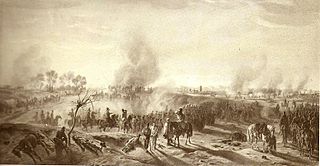
The Battle of Mortara was a battle between 19,000 Austrian and 26,000 Italian forces on 21 March 1849.


















